Much of the functionality available from the Columns panel is also available from the Tables panel; whether you choose to manage column visibility and metadata from the Tables or Columns panel will largely depend on personal preference.
Like the Tables panel, the Columns panel allows you to configure columns by managing their visibility, assigning data categories that will enable certain functionality for end-users, create measures and multi-measures, assign formatting to measures, and sort columns and measures into display folders. Unlike the Tables panel, you can also manage column sorting here.
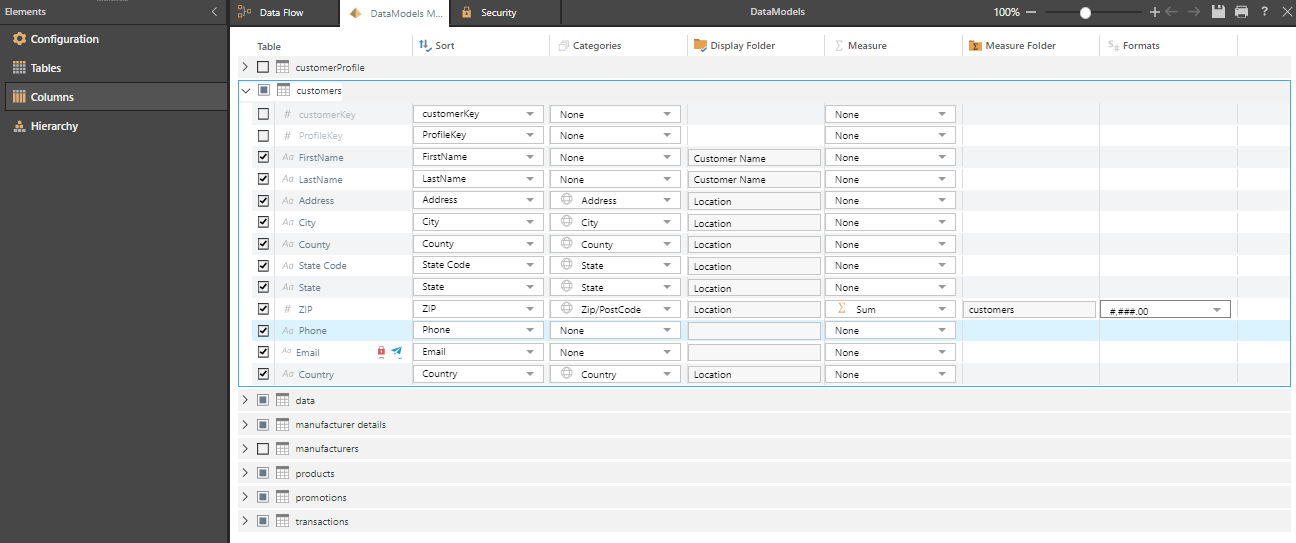
Adding Calculated Columns
Calculated columns can be added to a table by clicking on the "Add column Calculations" to the right above the column details, indicated by the red box below;

This will open the Calculated Columns graphical editor where the logic of the calculation can be defined. Once a calculated column has been dded to the table, it appears as a new row in the list of columns and can be treated like any other materialized column in terms of setting its properties as described below.
- Click here to learn more about creating calculated columns
Column Visibility
Visibility determines which tables and columns will be visible in the data model. Pyramid automatically detects key columns and hides them, so they will not be visible in the data model unless you make them visible.
Pyramid also detects measure columns and assigns a measure aggregation to them. This means that they won't be visible as columns in the data model; instead they will be organized into measure folders and will be visible as measures.
Show or hide a column by checking or unchecking its checkbox.
- Click here to learn more about column visibility.
Sort
You can sort a column by another column in the same table by selecting an option from the drop-down list. By default, each column is sorted by its own values.
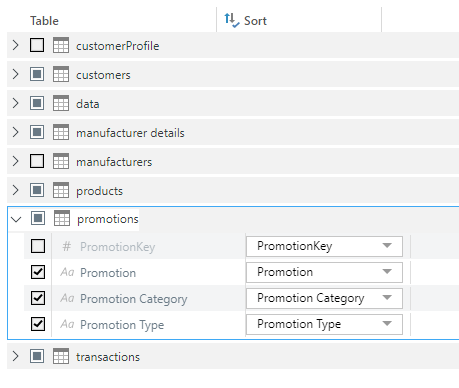
- Click here to learn more about sorting.
Categories
Relevant columns should be categorized in order to enable various functions later on, such as map visualizations, and date and time calculations. The categories to choose from include date/ time, geospatial, machine learning, and custom map files that have been imported via the Admin console.Categories can also be assigned using Pyramid's column categorization AI feature.
The Categories column displays the category assigned to each column:
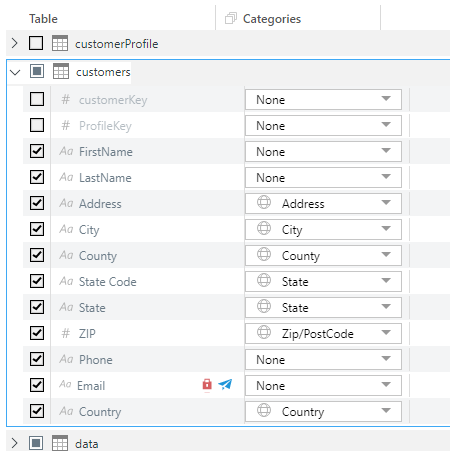
To assign a category to a column from the Columns panel, select the required category for from the Category drop-down list:
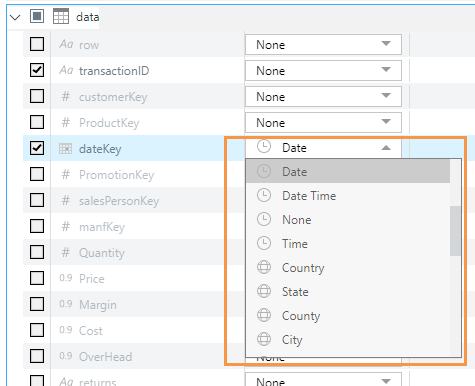
AI Categorization
Columns can be categorized using Pyramid's AI column categorization feature. Right-click on the table name and select AI Column Categorization. The system will generate categories (if applicable) for all columns that have not been assigned to a category.

- Click here to learn more about categories.
Display Folder
This field allows you to set a folder name for the column. In Discover, columns (referred to as hierarchies) are grouped according to the table (known as dimensions) to which they belong. At this stage of data modeling, users can define additional grouping criteria by placing columns into sub-folders. This can make it easier to navigate large dimensions later on in Discover.
To place columns into folders from the Columns panel, enter the folder name in the column's corresponding Display Folder field:

- Click here to learn more about column display folders.
Measures
Pyramid uses heuristics to automatically detect measures and assign an appropriate aggregation type to them. You can change the measure aggregation type, assign measures to text and date/ time columns, assign multiple measures to a column, and more. Change the measure type from the Measure drop-down list, or from the Tables panel.
Measures are displayed from the Measure column; a measure can be assigned to a column by selecting the measure type from the column's corresponding measure drop-down list.

To assign multiple measures to a column, scroll down the drop-down list and select Add Multiple Measures.
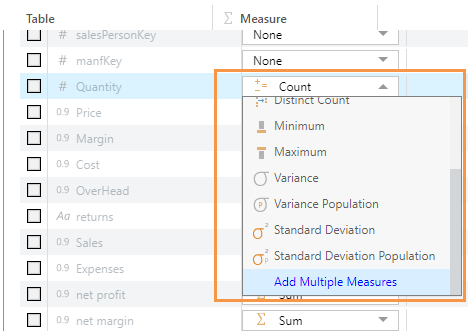
- Click here to learn about configuring measures.
- Click here to learn about multi measures.
- Click here to learn about the Multi Measures panel.
Measure Folders
This is the folder where the corresponding measure will be located in the measures tree in Discover.
Measures not added to a measure folder will be auto-grouped into measure group folders in Discover. Measure folders are displayed in the Measure Folder column:
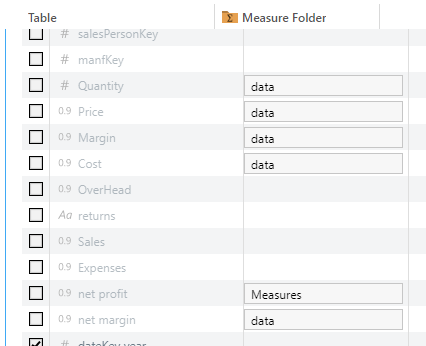
Measure folder names can be changed directly from the column's Measure Folder field:

- Click here to learn more about measure folders.
Formats
This indicates the format of the measure. Change the format by selecting one of the drop-down options, or enter a custom format (red arrow below). Formats can be edited by individual users from Discover; this edits the measure overlay for that user only. Admins can also edit measure formats when editing the measure overlay from the Admin console.
Column formats are displayed in the Formats column:
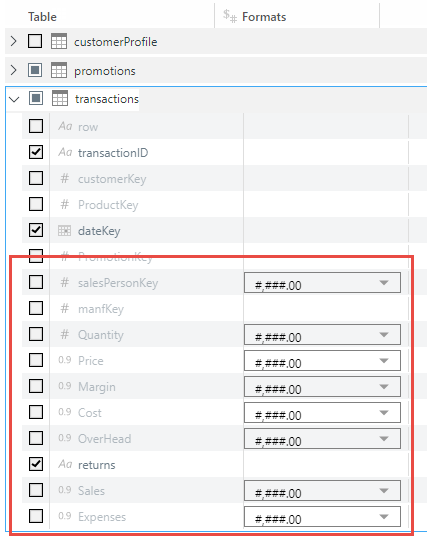
Change a column's format from the corresponding Formats drop-down list:
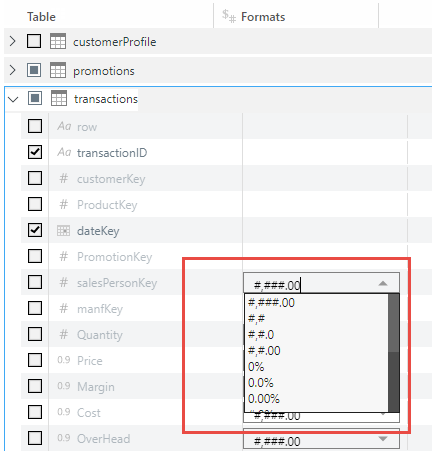
- Click here to learn more about measure formats.
Editing Column Metadata
Individual users can change the categories for selected columns from Discover, as well as the column caption (name). They can also change a measure's caption and format. This is called a hierarchy or measure overlay. When a user applies an overlay from Discover, the overlay will be visible to that user only.
However, Admins can assign hierarchy overlays and measure overlays to specified roles, in order to present hierarchies and measures differently to different user roles. Admins can create overlays consisting of an alternative display folder, description, name, category type (for members), and format string (for measures).